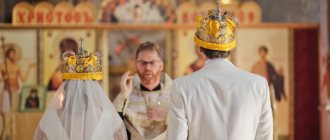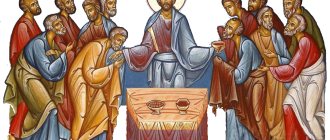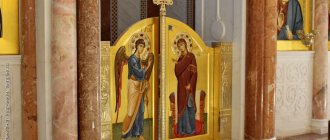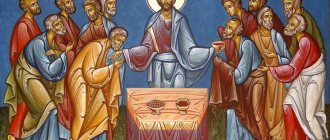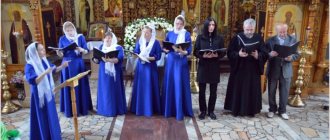What kind of service is this? Definition
The name of the service indicates that it should obviously take place at night. And the term “all-night vigil” speaks of the duration of prayers - until dawn. The Greek name for the service, “ἀγρυπνία” (“agripinia”), meaning both “sleeplessness” and “vigilance,” suggests the same thing.
Night prayers in the early Christian church
Indeed, the tradition of praying especially fervently during the night was known even among the first Christians. It goes back to the Lord Himself. The Gospels tell of His nightly prayers:
- before the election of the 12 disciples to the ministry (Luke 6:12);
- on the eve of the Transfiguration (Luke 9:28);
- before being handed over to the Jews in the Garden of Gethsemane (Matt. 25:36).
Useful materials
The Apostles often prayed at night. St. Luke talks about how St. Paul and Silas at night in prison “prayed and sang praises to God; and the prisoners listened to them” (Luke 16:25). The tradition of long night prayers gradually established itself among believers.
True, the vigil from sunset to dawn was performed by the first Christians only on special occasions, for example, on the eve of Easter. For the most part, prayers ended around midnight.
Monastic tradition
With the establishment of Christianity in Byzantium, long periods of prayer became the lot of monks, but not everywhere.
The 2 most common from the 6th-8th centuries are known. liturgical regulations of monks - Constantinople Monastery of St. Theodora (the monastery was also called Studio, named after the senator who once founded it) and the monastery of St. Savva the Sanctified near Jerusalem.
Based on their places of origin, these charters were called Studite and Jerusalem, and their attitude towards night prayers was different:
- monastery of St. Theodora was a dormitory, the monks lived under the direction of the abbot; long divine services were performed daily, no additional night vigil was required; but, like the first Christians, the Studians could perform similar services on the eve of major holidays;
- St. Savva was the spiritual leader of the hermit monks, who prayed in their cells throughout the week, only coming to the common church on the eve of Sunday; fathers who spent a week without Divine service needed spiritual reinforcement with especially intense prayer; Naturally, therefore, a long vigil on the eve of holidays and Sundays appears in the Jerusalem Rule.
In Russia
Russian liturgists at the beginning of the 20th century. It has been established that in Rus' three liturgical Rules successively replaced each other:
- introduced, apparently, under Prince Vladimir the Holy (10th century) Typikon of the Church of St. Sophia of Constantinople, the parish church, where the vigil was not provided;
- Studiysky, brought to Rus' under St. Theodosius of Pechersk (XI century); thanks to the high authority of the saint, it spread throughout the parish churches;
- Jerusalem, which appeared on Russian churches from the 14th century, when it spread to Byzantium; This monastic Charter of worship also extended to parish churches: there was no special charter specifically for secular churches in Rus' and does not exist to this day.
History and significance
The interpretation of the all-night vigil is very simple - it is a night prayer performed by Christians on their knees. Many great saints believed, and still believe, that prayer is the highest of virtues. Deeds can help a person, but when we pray, God Himself descends and helps. It was said about some prayer books in history that enemies were afraid of their prayers in an army of more than ten thousand.
As you read Scripture, it is easy to notice accounts of such practices already in the Old Testament church. For example, Joseph, the son of Israel, had the custom of going out at night to pray and reason. And also King David often did not allow himself to fall asleep in order to be alone and pray. The most important confirmation is the Lord Jesus Christ Himself and His apostles.
But historically, the all-night vigil was defined and officially recognized by the Church during the time of John Chrysostom. Over time, the order of this service was improved and enriched by other saints, such as John of Damascus and Theodore the Studite. The vigil is often associated with the calling of Christians to always be sober, to pray unceasingly and to remember that the Lord is coming.
Especially during times of persecution, Christians gathered for general prayer at night. They were often accused of corrupting children, of atheism, cannibalism, and other terrible things. Since they had to hide from the authorities, they chose more secret places, in catacombs and cemeteries.
In the II-III centuries. Ekah the movement of hermits and monks spread greatly. In addition to asceticism, they often spent the entire night in prayer, singing and praising. For the Church Fathers, the vigil had eschatological connotations. Vigil was considered a way of spiritual life. A Christian must always remember the cross of Christ, the Holy Gospel, forgiven sins and the reward in heaven for faithfulness. The Greek term "agrypnia" appears in the writings of Basil the Great. He wrote that such meetings were held in many places in the East and took place on the eve of Sundays.
How long does such a service last?
Thus, the appearance of the all-night vigil in Russia dates back to the 14th century. Over time, it turned out that the Russian service was much longer than that performed by Greek monks.
According to the Charter, the vigil begins at sunset and ends at dawn. But in Russian latitudes, the duration of the night is significantly longer, especially in winter.
Therefore, as modern liturgist A.M. points out. Pentkovsky, in order to extend the time of the service, added Compline, Midnight Office, and canons. This is how a statutory service lasting up to 8-10 hours was formed.
This is exactly how it was performed in Russian churches until the middle of the 17th century, when Patriarch Nikon carried out a liturgical reform. Since that time, although the Charter of this service has not changed, the practice has arisen of reducing it to a few hours.
All-night vigil
Order of worship
As already mentioned, its temporary duration has changed somewhat. How long does the all-night vigil last in church? Since the church is attended mainly by people of quite advanced age, it was decided to show leniency towards them and its duration was shortened. Now it doesn't start late and doesn't last all night long. In the modern world it takes about 2-3 hours.
Since this service is held before major and revered church holidays, it is worth knowing that the task is to cleanse the brain of negativity and tune in to perceive a positive spectrum of emotions. Many priests say that holding it carries the history of the Old and New Testaments. There is also a certain rite for the all-night vigil. The main ones are aimed at:
the opening of the Royal Doors and the commemoration of the creation of the world; the beginning of such an action is also called Great Vespers; then the priest burns incense to the temple and those present while singing a psalm glorifying the wisdom of the Lord; the closing of the gate indicates that an original sin has been committed and prayers are already directed at them. All subsequent texts talk about how the people's situation worsened after such a rash act; the reading of the stichera to the Mother of God is accompanied by the priest passing through the northern doors of the altar and entering the Royal Gate - this symbolizes the emergence of the mission; the advent of Matins will mark the beginning of the New Testament; its main part consists in expressing gratitude to the Lord for the gift of the Savior; then they begin to read texts from the Gospel, which relates to the celebration, and the canon.
Also read: What not to do in a cemetery?
Remember that whether to take part in church ceremonies or not is purely an individual decision. But it is worth remembering that simply giving up on this is not beautiful. If you believe, then follow the church rules and canons.
The Lord is always with you!
Prayer for oncology to the All-Tsarina When trouble comes to the house, people fall into despondency and despair. The Lord sends those tests that are within a person’s strength, and a prayer to the All-Tsarina in case of oncology for a sick relative will help. A cancerous tumor is its… Read more
The prayer to the Mother of God “Virgin, Hail, Gracious Mary, the Lord is with You” “Virgin, Hail, Gracious Mary, the Lord is with you” is one of the most powerful prayers in all of Orthodoxy. A great many real miracles are associated with it, confirmed by facts and evidence from huge numbers… Read more
Icon of the Mother of God and Jesus Christ: meaning and its help The Virgin Mary is the mother of Jesus Christ. Therefore, the icon of the Mother of God with the baby Jesus is the main female image in Orthodoxy. Her face carries a special meaning. It symbolizes chastity and righteous … Read more
Prayer to St. Nicholas the Wonderworker from prison There is a saying among the people: “Don’t swear off money or prison.” Our life is very changeable and anything can happen that we cannot even imagine. You can’t be sure that you won’t be framed or you won’t… Read more
Prayer to Nicholas the Wonderworker for pregnancy For every woman, the opportunity to give birth to a child is an incredible miracle that helps strengthen the family and experience all the delights of motherhood. Some people manage to get pregnant the first time, but some experience problems with… Read more
Prayer to preserve pregnancy to St. Nicholas the Wonderworker Prayer to preserve pregnancy and the birth of a healthy baby to saints and turning to them for help will help you overcome all difficulties. Children are not only the joy that they bring with their appearance into our world. This is… Read more
All-night vigil - explanation of church services
Interesting read:
Baptism of a boy: what the godmother and godfather need to know. Is masturbation a sin or a natural need?
Is it possible to wear someone else's cross? When to open mirrors after a funeral? Why are pregnant women not allowed to attend funerals? What should you not do at a funeral? On what days should the dead not be buried? How to prepare for confession for the first time? How to light a candle for health in church? Rules for holding a wake 9 days after death The procedure for holding a wake 40 days after death and whether it can be held earlier What is needed for the baptism of a girl child? What is a sorokoust about health and when is it ordered? Tags: service what you need to know
"Historical Vigils"
At the beginning of the 20th century. Russian liturgists, professors of the Kyiv Theological Academy M.N. Skaballanovich and V.F. Pevnitsky, with the help of the clergy and students, organized the All-Night Vigil in full accordance with the Charter. This unique service began at 6 pm and ended around 2 am. M.N. Skaballanovich testifies:
“It is difficult to express in words how the listeners of this service, which someone called the “historic all-night vigil,” and especially its closest participants felt... Most of the performers of the service decided the next day that they had been drunk during the all-night vigil. There was no question of any fatigue. One singer stated that he could, without leaving the choir, sing another all-night vigil for God. One student, a lover of sleep, left the church several times, undressed, went to bed, but, unable to fall asleep from the thought that such an original, unheard of concert was taking place a few steps away, he returned to the church... Those acquaintances of the leaders who were not there notifications were sent about the upcoming all-night vigil, they almost quarreled with them because of this and took their word that if anything like this were repeated they would be notified. And repetition is possible..."
However, no one was able to repeat this experience for many years. Today, the full all-night vigil is constantly served only in Old Believer and Edinoverie parishes.
Some parish churches are also following the path of full implementation of the Charter. This is most consistently implemented in the Church of the New Martyrs and Confessors of Russia in Strogino (Moscow). Here since the early 2000s. On the initiative of the rector, Archpriest Georgy Krylov, a circle of Znamenny singing was created; parishioners studied ancient liturgical traditions for many years.
17
June
2011
Patriarch Kirill of Moscow and All Rus' blessed the rector of the church, Archpriest. George, to perform the all-night vigil in the old rite (which existed before the reform of Patriarch Nikon) every week, on Saturdays.
History of origin
The custom of spending the night hours in Christian prayers, which came to us from ancient times, began like this:
During his stay in the earthly world, Jesus Christ often spent the night in prayer. Following the example of the Savior, his disciples - the apostles - held night meetings, as they were afraid of numerous enemies. For fear of persecution from Jews and pagans, they gathered in catacombs (caves) at night , located at some distance from the city) Christians who were pioneers of the faith. This happened on holidays and on the days of remembrance of the holy martyrs. The meaning of the all-night vigil is to depict the events that happened with Jesus Christ on earth, which led to the salvation of the human race. Christ took upon himself human sins, was crucified and ascended, defeating death.
The all-night vigil before Sunday or a church holiday has its own sequence and is divided into three parts:
Vespers. Matins. First hour.
You definitely need to know what a nativity scene and nativity scene is.
In simple words about the complex
The meaning of the word in Orthodoxy, how does it differ from evening worship?
In most Orthodox parishes in modern Russia, the all-night vigil consists of services running one after another:
- Great Vespers (on the eve of major holidays - Compline);
- Matins;
- First hour.
Such a service is performed on the eve of Sunday services, as well as before great holidays, days of remembrance of especially revered saints, patronal feasts of a particular church.
In addition, at the request of the rector, or according to local tradition, it can be performed on the eve of any other church celebration in memory of a particularly revered saint.
The difference between the all-night vigil and the evening service on weekdays is its greater solemnity and duration, since during it:
- as a rule, special proverbs (passages from the Old Testament) are read from the book in memory of a holiday or a great saint being remembered;
- lithium may be served and the consecration of the loaves may take place;
- as a rule, several canons are read;
- the believers are anointed with oil.
Duration on Saturday and other days
In most churches the service lasts about 2 hours; in monasteries its duration can increase to 3 hours. The service usually begins at 5 or 6 p.m.; the practice of praying throughout the night is now very rare.
Is confession allowed?
According to established practice, confession is usually held during the evening service. The all-night vigil is no exception.
At the same time, in small parishes where there are not enough clergy, the sacrament can be postponed until after the service, or the morning before the start of the liturgy. Therefore, it is better to find out the time of confession in a specific church.
Differences between the All-Night Vigil and Evening Worship
In Orthodoxy, the Evening Service and the All-Night Vigil equally occur on the eve of Sundays and holidays.
However, the evening service can begin at 16 or 19 hours and last until 21 or midnight, including only the first or second part of the All-Night Vigil.
But the All-Night Vigil, unlike Vespers, has two main parts: evening and morning, with the addition of 1, 3, 6 and 9 hours of worship, and begins at 17:00 until the morning.
Throughout the service, words of thanksgiving addressed to God are spoken. And the entire All-Night Vigil is permeated with a reminder of who is a man and who is the form of a beast that has not realized its actions. This is the meaning of the All-Night Vigil, to understand yourself and your actions, and, having realized, to repent and draw closer to the Lord.
Components with explanations
Parts of the service symbolically depict the path of humanity, the history it has traversed from the creation of the world to the Incarnation of Christ.
Vespers
The first exclamation of the priest that opens it is “Glory to the Holy, and Consubstantial, and Life-Giving, and Indivisible Trinity...”. This is the glorification of God for creating the world. Then the priest walks around the church with a censer, while the choir sings Psalm 103, dedicated to the beauty of the world, which God “with wisdom created.” Thus, believers are called to remember Paradise, where He Himself was in communion with Adam. It is not for nothing that during censing the gates to the altar are open, symbolizing the unity of the Creator and His creation.
At the end of the censing, the gates are closed. The petitions that the deacon pronounces before them are the cry to God of a sinned person deprived of Paradise.
Old Testament verses of repentance are also sung, and then Sunday hymns, or the celebrated event. The last of them is always dedicated to the Mother of God, thanks to Whom Paradise became possible again for people.
After this singing, the royal doors open and the evening entrance of the priest and deacon takes place during the hymn “Quiet Light of Holy Glory...” dedicated to Christ.
An important moment of the service is the proverbs read on major holidays - excerpts from the prophetic and other Old Testament writings, prophetically predicting the celebrated event.
Lithium
This service takes place on major holidays. The clergy usually proceed from the altar to the middle of the temple or closer to the entrance, and make special prayers for the believers, the Church.
In the first centuries of Christianity, it was customary to go out to the litany in the vestibule, where the penitents who were not admitted to the sacraments stood, so that they could participate in the general worship.
According to the litia, the priest blesses 5 loaves, oil, wine, and wheat. Nowadays this is understood as a remembrance of the Lord feeding 5,000 people in the desert with five loaves.
Interesting fact
In ancient times, the rite also had a practical meaning: after the litia, bread was distributed to pilgrims and other pilgrims who came from afar.
Vespers ends with the reading of the prayer of St. Simeon the Receiver of God, uttered by him at the Meeting of the Lord (“Now dost thou let thy servant go, O Master...”) and the prayer “Virgin Mother of God, rejoice...”, which marks the Incarnation of Christ.
Matins
This service is all dedicated to Christ. It begins with the words of the Angel’s greeting, which at one time announced to the shepherds about the Birth of the Savior: “Glory to God in the highest, and on earth peace, good will toward men.”
Six Psalms
Then the lamps and all the candles are extinguished. Going out to the middle of the church, the sexton begins 6 psalms, which form the Six Psalms and depict the misfortune of man, the expectation of God's help.
St. Pasisy Svyatogorets says:
“The Six Psalms symbolizes the Last Judgment. Therefore, it is good if, while reading the Six Psalms, the hour of the Last Judgment comes to mind. After the first article (the first three psalms), we do not even get baptized, because Christ will not come now to be crucified, but will appear to the world as a Judge.”
After the Six Psalms, the deacon pronounces a litany (prayer requests), and a kathisma from the Psalter is read.
Polyeleos
Then comes the most solemn moment of Matins - after the incense of the church, the Gospel is read, and then the polyeleos begins: the believers, while reading the canon of a holiday or a saint, are anointed with oil consecrated at the litany.
The service ends with the singing of “praise” psalms and stichera glorifying God. The culmination is the Great Doxology, which begins with the exclamation “Glory to Thee, who showed us the light!” In ancient times, when prayer was performed all night, by this time the sun had risen, all believers glorified the coming of a new day.
First hour
At the end of Matins, a sequence of 1 hour is performed, during which God’s blessing is asked for the new day. This short service includes:
- Psalms 5, 89, 100;
- prayers dedicated to the Mother of God and troparia for the celebrated event;
- closing prayers.
Following the All-Night Vigil in Orthodoxy
To gain true freedom of spirit, to get out of the bustle of the world, long-term divine service is necessary. This service is the All-Night Vigil.
It helps free the soul from obscurantism, helps to comprehend the sacred holiday and accept grace.
Before the Liturgy, symbolizing the future age, the Kingdom of God, the All-Night Vigil shows the previous events occurring in the Old and New Testaments.
The entire service would be incomplete without the psalms that run throughout the service. The singers on the choir chant or read psalms selectively or in full, continuously creating the entire atmosphere of the All-Night Vigil.
At the beginning of the All-Night Vigil, as if mental images of the main moments in the Old Testament, the sacrament of Great Vespers occurs: the clergy at the altar proclaim the creation of the world, the descent of the Holy Spirit and the Holy Trinity, opening the Royal Doors in the altar.
Next, the wisdom of God, who created the world, is sung and glorified in Psalm 103, and the priest goes around with a censer, fumigating the entire temple and all those praying. Further, recalling the Fall, the Royal Doors are closed, and prayer is offered, stichera and psalms are read about the repentance of the human race.
Next, the stichera dedicated to the Most Holy Theotokos ascends, and the priest, accompanied by a deacon with a censer, passes through the northern altar doors and majestically enters the central Royal Doors, announcing the predicted appearance of the Savior in the world, ending the first part of the All-Night Vigil.
In the morning part of the service, the New Testament story begins, speaking about the coming of the Lord into the world of people, about his birth, crucifixion and great resurrection. It all starts with reading poetry, six important psalms.
Then, with the solemn part glorifying the mercy of God, which revealed it through the birth of the Savior, chants, polyeleos, praising the Lord begin, with the opening of the Royal altar doors wide and the widespread lighting of lamps.
At the end of the All-Night Vigil, the Holy Gospel is read.
Features for the Presentation of the Lord
Meeting is the twelfth holiday, which may coincide with the time of preparation for Great Lent, as it is celebrated in February. The Charter contains various liturgical instructions about the peculiarities of the all-night vigil for this holiday in such cases.
When Candlemas coincides with the days when the Lenten Triodion is sung, at the festive vigil one can hear repentant chants, preparing believers for fasting. But if Candlemas falls on the 1st day of Great Lent, then the service is moved to the previous Sunday, respectively, the vigil falls on the Saturday before.
